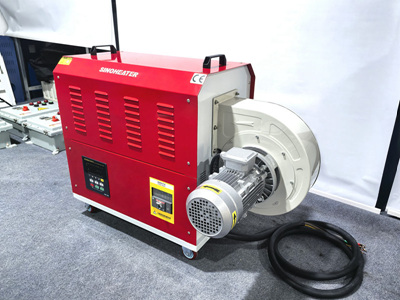Temperature Control Techniques for Ceramic Painting Using Hot Air Blowers
Ceramic painting relies on precise thermal management to achieve vibrant colors, stable adhesion, and artistic effects. Hot air blowers, when integrated with traditional firing techniques, enable artists to control pigment reactions and material transformations during the creative process. This guide explores temperature settings for different ceramic pigments, heating protocols, and quality optimization strategies.
Temperature Ranges for Ceramic Pigment Activation
Underglaze Pigment Firing
Underglaze pigments, applied beneath transparent glazes, require high-temperature activation to bond with ceramic bodies. For cobalt blue or iron red underglazes, a firing range of 1280–1320°C in reduction atmospheres is critical. This temperature ensures color saturation while preventing pigment diffusion into the glaze layer. Artists must monitor窑炉 (kiln) atmospheres, as oxidation can dull cobalt-based hues.
Overglaze Enamel Melting
Overglaze enamels, used for surface decoration, demand lower temperatures to avoid glaze deformation. Typically, these pigments melt between 760–820°C in oxidation environments. For example, gold overglaze (liquid enamel) requires 780°C to achieve a metallic luster. Overheating beyond 850°C may cause color fading or blistering.
Luster and Metallic Pigment Processing
Luster pigments, such as iridescent gold or platinum, rely on controlled reduction during firing. A two-step process involves:
- Initial Firing: Heat to 600–700°C in oxidation to fix pigments.
- Reduction Phase: Lower oxygen supply and raise temperature to 750–800°C to trigger metallic crystallization.
This method produces thin, reflective layers without compromising base glaze integrity.
Heating Protocols for Pigment Stability
Gradual Ramp-Up for Color Consistency
Abrupt temperature changes can cause pigment cracking or uneven melting. For underglaze decorations, adopt a three-stage heating curve:
- Drying Phase: 50–100°C for 2 hours to evaporate moisture.
- Bisque Firing: Slowly increase to 900°C over 4 hours to harden the ceramic body.
- Glost Firing: Rapidly ascend to 1280–1320°C within 2 hours for pigment activation.
This approach minimizes thermal shock and ensures color uniformity.
Controlled Cooling to Prevent Cracking
Post-firing cooling rates significantly impact pigment adhesion. For overglaze enamels, a natural cooling process (10–15°C/hour) below 600°C is recommended. Rapid cooling may induce stress fractures, particularly in thin-walled porcelain pieces.
Atmosphere Adjustment for Pigment Reactions
The firing atmosphere directly affects pigment chemistry:
- Reduction Atmospheres: Used for cobalt-based pigments to enhance blue intensity.
- Oxidation Atmospheres: Preferred for iron-red pigments to prevent grayish tones.
Artists can adjust窑炉 (kiln) gas mixtures or use electric kilns with programmable oxygen levels to achieve desired effects.
Advanced Techniques for Artistic Effects
Crystalline Glaze Development
Crystalline glazes require precise temperature cycling to grow zirconium silicate crystals. The process involves:
- Nucleation Phase: Heat to 1260°C and hold for 30 minutes.
- Crystal Growth: Rapidly cool to 1180°C and soak for 2 hours.
- Final Cooling: Slowly descend to room temperature to stabilize crystals.
Hot air blowers can assist in localized temperature adjustments during soaking phases.
Raku Firing for Metallic Surfaces
Raku techniques involve removing pieces from the kiln at 900–1000°C and placing them in combustible materials (e.g., sawdust). The reduction atmosphere creates iridescent metallic effects. Hot air blowers can pre-heat reduction chambers to ensure even smoke distribution.
Multi-Layered Pigment Application
For complex designs, artists layer pigments with varying melting points. For example:
- Apply underglaze at 1280°C.
- Overlay overglaze enamels at 800°C.
- Add luster pigments at 750°C.
This sequential firing requires precise temperature control to prevent interlayer reactions.
Quality Assurance and Troubleshooting
Pigment Adhesion Testing
After firing, inspect pigments for:
- Crazing: Fine cracks indicating thermal stress.
- Blistering: Air bubbles trapped under the glaze.
- Color Shifting: Hues deviating from intended shades.
Adjust heating rates or pigment formulations if defects occur.
Kiln Calibration for Reproducibility
Use pyrometers or thermocouples to verify窑炉 (kiln) temperature accuracy. A ±10°C deviation can alter pigment behavior. Regularly calibrate kilns and document firing cycles for consistent results.
Environmental Considerations
Humidity and ambient temperature affect pigment drying. In humid climates, extend drying phases by 20–30% to prevent moisture-related cracking.
By integrating these temperature control techniques, ceramic artists can achieve precise pigment activation, vibrant coloration, and durable finishes. Continuous experimentation with heating protocols and material interactions ensures mastery of this ancient yet evolving craft.




